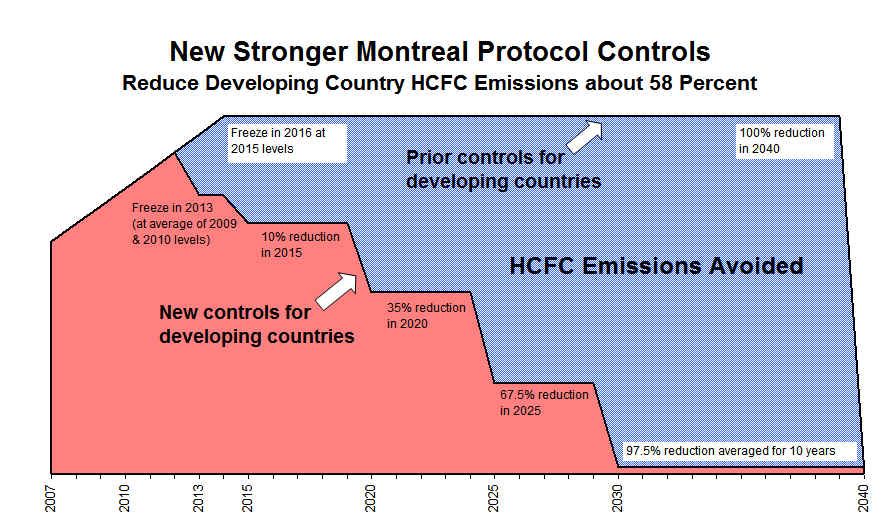The ozone layer found in the stratosphere(approximately 90% of Ozone is here) is approx 15-35 kms above Earth’s surface, with abundance of Ozone molecules.
The natural level of ozone in the stratosphere is a result of right balance between sunlight that creates ozone and chemical reactions, that destroys it.
Unfortunately, we, humans do not leave this natural process undisturbed and hence like cancer cells proliferate, killing all the right cells if disturbed.
The consequent destruction of Ozone leads to a hole in the face of Life.
The ozone layer acts as an invisible shield or “sunscreen layer” that naturally protects us from harmful ultraviolet (UV) radiation from the sun. In particular, it guards us against the UV radiations, namely UV-B that causes sunburn.
Long-term exposure to high levels of UV-B threatens human health and damages most animals, plants and microbes, so the ozone layer protects all life on Earth.
Skin cancers, eye problems, food contaminations and numerous damages to our Environment could have been so common.
Thanks to the Human wisdom, at times.
By the mid-21st century, severe ozone depletion would have spread across the planet, including the tropics.
But The Vienna Convention was formed for the Protection of the Ozone Layer was adopted in 1985.

In 1989 came the Montreal Protocol(often called the ‘World Avoided’). It was designed to protect the ozone layer by phasing out the production of numerous substances that are responsible for ozone depletion like CFCs.
Chlorofluorocarbons(CFCs), which at one time were widely used in air conditioners, refrigerators, aerosol cans, and in inhalers used by asthma patients. Other chemicals, such as hydrochlorofluorocarbons (HCFCs), halons and methyl bromide also deplete the ozone layer. Most of our computers, electronics and parts of our appliances were cleaned with ozone-depleting solvents.
In order to include HCFCs into the genre of Ozone depleting substances(ODS), the Kigali Agreement was made.
And with this triple action, there has been huge blow to the usage of such harmful ODSs.
Good and bad Ozone:
Ozone high up in the stratosphere provides a shield to protect life on Earth, It is good when not in direct contact. When scientists talk about the ozone hole, they are talking about the destruction of stratospheric, “good,” ozone.
Ground-level or “bad,” ozone forms when nitrogen oxide gases from vehicle and industrial emissions react with volatile organic compounds (carbon-containing chemicals that evaporate easily into the air, such as paint thinners). It can cause lung and throat irritation.
In 2018, a report suggested that portions of the ozone layer have recovered at a rate of 1% to 3% per decade since 2000 but NOAA( National Oceanic and Atmospheric Administration) observed a smaller decrease in the decline of atmospheric CFC-11 than expected. It was a trailer for another revelation ahead.
The numbers didn’t align with trajectories based on CFC-11’s production ban, hinting that something had changed. “The slow-down in the rate of decline indicated that somebody was emitting again, or in larger quantities than we were expecting, we just didn’t know where,” says Matt Rigby, University of Bristol (UK) scientist and one of the lead authors of the new study.
This appeared much like a detective work.
This suggested that the eastern Chinese and overall global emissions of CFC-11 after mandated global phase out in 2010, have returned to previous levels.
Though these new CFC-11 emissions were identified relatively quickly, they have the potential to delay ozone layer recovery, especially if left unchecked, so a timely response is paramount.
Since CFC is also a greenhouse gas, limiting and checking upon it must have dual effect and service to the healing Earth.
Much of this research was found by NASA and the National Oceanic and Atmospheric Administration (NOAA), who work together as part of a long-running research partnership to monitor emissions of stratospheric ozone.
Advanced Global Atmospheric Gases Experiment (AGAGE) – a network of monitoring stations funded by NASA and several environmental agencies, also keeps a monitoring eye on the Ozone change.
Refer this all custom graphical data related to Ozone.
India and Ozone
Back in 2005, it was informed that there developed a decadal variation in the ozone column over the densely-populated basin that is almost three times the predicted trend for the decade.
It produced a chilling effect on the efforts made by the provided Protocols.
And Indian Agricultural Research Institute(IARI) showed that the 26 million hectare rice-wheat cropping system in the Indo-gangetic plain releases huge quantities of nitrous oxide into the atmosphere, that is known to destroy stratospheric ozone.
However soon enough, India started the work that was supposed to be completed.
India consciously chose a path for environment friendly and energy efficient technologies while phasing out Ozone Depleting Substances (ODSs).
India achieved huge success in “Hydrofluorocarbons Phase Out Management Plan (HPMP)“.
This led to twin environmental benefits:
(i) assisting the healing of the stratospheric ozone layer
(ii) towards the climate change mitigation due to transitioning of foam manufacturing enterprises at this scale under HPMP to low global warming potential alternative technologies.
However The continued success of the Montreal Protocol in its goal to eliminate HCFCs by 2030 will depend on reducing the acquisition costs of cleaner technologies.
By 2030s, Northern Hemisphere may heal completely.
Similarly Southern hemisphere can heal only by 2050s.
India can take that road in due time.







